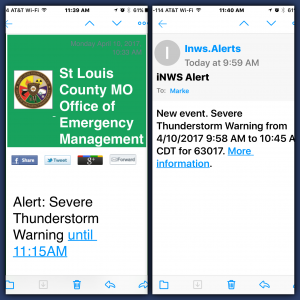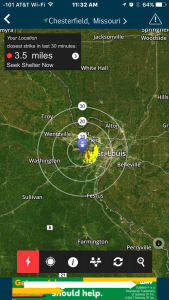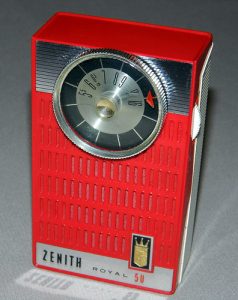 Spring is here, and for many Americans, it’s the start of the severe weather season. Time was when the thunder started and the skies turned dark that people would grab their trusty transistor radio to get the latest information on what was happening with the weather. It was pretty much the only way to know what was going on short of having your own weather station at home.
Spring is here, and for many Americans, it’s the start of the severe weather season. Time was when the thunder started and the skies turned dark that people would grab their trusty transistor radio to get the latest information on what was happening with the weather. It was pretty much the only way to know what was going on short of having your own weather station at home.
Those days are WAY gone. A combination of TV learning how important severe weather coverage is, radio stations being gutted of live announcers, (especially in the evenings and nights when a lot of severe weather strikes) and the hundreds of weather apps available for smartphones, as well as many free email weather notification services, makes it easier and more accurate to use your battery-powered internet-connected device of choice to get up to the second weather information when things get hairy.
Get Severe Weather Updates Sent To Your Device
Whether you choose to use your phone, laptop, or tablet, there are many ways to get severe weather information at the same time, sometimes earlier, than the media does. The National Weather Service has aggregated over fifty sources of free text message and email weather alerts on their website. Some, of course, are better than others, but a good idea would be to subscribe to a few services, see which give the fastest and most accurate messages, and stick with at least two services. I use Nixle, a service supported by many state and local governments and a service being developed by the NWS as my two services. They provide both text messages and email alerts.
These are obviously screenshots from my phone, but you can scroll down for all the details of the message or click on the link to go to the details on a website. There are many services like these, I just prefer these two. Nixle also provides Amber Alerts, messages from local Law Enforcement, and more. All you have to do is text your zip code to them and you’re signed up.
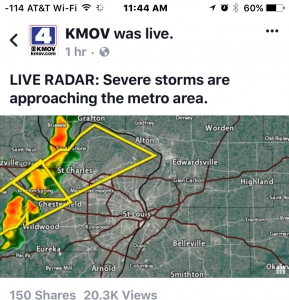 Most local TV stations stream severe weather coverage through their website, app, or as one of the St. Louis stations did today, through Facebook. It took TV stations a little while to figure out that if you’re hiding in the basement during a storm, you may not have access to a TV, but they’ve largely gotten their act together and make their severe weather coverage easy to find. This was a feed of the station’s radar, but you can usually find full coverage with a meteorologist on the station’s app, often when the coverage isn’t being broadcast. Just about all TV apps are free, so you can easily download apps from all the stations in your market and see who does the best job.
Most local TV stations stream severe weather coverage through their website, app, or as one of the St. Louis stations did today, through Facebook. It took TV stations a little while to figure out that if you’re hiding in the basement during a storm, you may not have access to a TV, but they’ve largely gotten their act together and make their severe weather coverage easy to find. This was a feed of the station’s radar, but you can usually find full coverage with a meteorologist on the station’s app, often when the coverage isn’t being broadcast. Just about all TV apps are free, so you can easily download apps from all the stations in your market and see who does the best job.
Weather Apps-Good, Bad, and Ugly
There is no shortage of weather apps in the iTunes and Google Play stores. Last I checked, there were over 300 weather apps for iOS and almost 7oo for Android. Many of the apps are free, many include push notifications when watches and warnings are issued, and some apps cost money, either for the app or to unlock special features. Here are three apps I depend upon most for weather information. I recommend each of them, and you’ll see the reasons for each app.
WeatherBug
This is an app I’ve been using forever, and it continues to get better. It’s a great general-purpose app, with radar, hourly and ten-day forecasts, multiple locations (I use that to keep track of the weather at the colleges my kids are at), live weather cams, and a couple of very helpful features you don’t find in many other apps. It’s free and available for both iOS and Android.
A particularly helpful feature of this app is called Spark. It looks for lightning and can be set to alert you when there’s electrical activity headed your way. The screenshot from the left is from just after a storm passed over my house and it shows the distance lightning is from where I was and represents the lightning strikes by the yellow dots.
Dark Sky
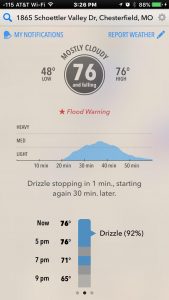 For the longest time, this was an iOS-only app, but it’s now available on Android as well. It’s about $4.00 and well worth the price. It can give you the forecast at your location, determined by GPS, or anywhere else you want. As the screenshot shows, it has a clean interface and a different way to prognosticate the weather. It gives you minute-by-minute estimates of the arrival of and intensity of precipitation using the table in the middle of the screen and the timeline near the bottom. It’s remarkably accurate in predicting precipitation and has been a huge help in planning for the rain or snow.
For the longest time, this was an iOS-only app, but it’s now available on Android as well. It’s about $4.00 and well worth the price. It can give you the forecast at your location, determined by GPS, or anywhere else you want. As the screenshot shows, it has a clean interface and a different way to prognosticate the weather. It gives you minute-by-minute estimates of the arrival of and intensity of precipitation using the table in the middle of the screen and the timeline near the bottom. It’s remarkably accurate in predicting precipitation and has been a huge help in planning for the rain or snow.
The cost might turn some people off, but if you do anything that involves having to be outdoors, it’s a small price to pay and it really works.
MyRadar
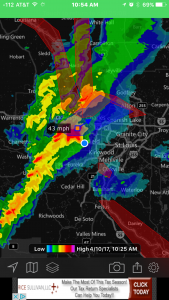 OK, Even I admit this one may be a little much, but it is truly incredible. MyRadar is available for Android and iOS, and the basic version is free. You can add a bunch of items, from hurricane trackers to professional radar, and if you are a weather geek like me, this is the best app out there to satisfy your geekdom.
OK, Even I admit this one may be a little much, but it is truly incredible. MyRadar is available for Android and iOS, and the basic version is free. You can add a bunch of items, from hurricane trackers to professional radar, and if you are a weather geek like me, this is the best app out there to satisfy your geekdom.
The view you see in the screenshot shows a few overlays, watches, warnings, radar returns, even the wind speed at the nearest radar site to my house. Lots of colors, but they each mean something. You can also show wind motion from the Doppler Radar, which can help you see rotation in clouds that could indicate the formation of tornadoes. The app may be overkill for some, but it’s as close as you can get to sitting in front of the radar screen at the Weather Service.
The bottom line is that if you subscribe to a couple of services that send text and email alerts, have the best local TV station app, and one or two weather apps, you’ll be covered in case the bad stuff heads your way. If you want to use the larger screen on your laptop, just bookmark the sites that match most of the services described here and you’ll have pretty much the same information.
Please don’t rely on local radio to keep you informed up to the minute or safe. It’s 2017, and there are far far better ways to get information that could save your family’s lives quickly, easily, and with very little work on your part.

